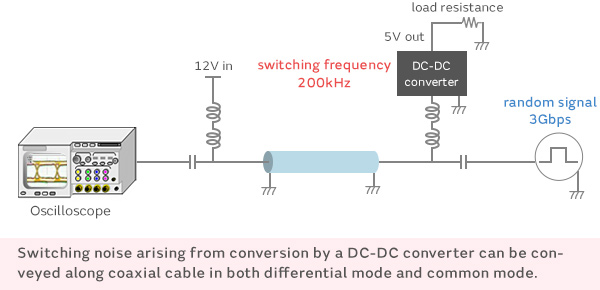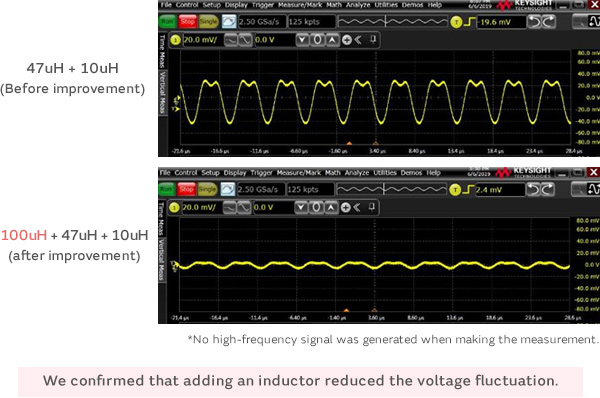[Murata Articles] PoC system requirements for inductors and noise supp…
- Writer : 최고관리자
- Date : 23-09-20 07:56
- Hit : 3,087회
본문
5. Effects of power supply noise on PoC systems
DC-DC converters are often used as power ICs in PoC circuits. However, since DC-DC converters perform high-speed switching internally, switching noise can be a problem. We looked at an example of the adverse effects on a PoC system of switching noise from a DC-DC converter. Switching noise can be conveyed along coaxial cable in both differential mode and common mode.

Problems caused by differential mode noise Effect on SI of power supply noise from switching
In a PoC system signals are conveyed along the coaxial cable in differential mode between the center conductor and shield layer. The waveform quality is good when there are no effects from external noise. However, if switching noise penetrates the coaxial cable, the quality of the waveforms transmitted in differential mode may suffer.
 Problems caused by differential mode noise Effect on SI of power supply noise from switching
Problems caused by differential mode noise Effect on SI of power supply noise from switchingWe checked the difference in signal integrity (SI) of SerDes signals when multiple inductors are used in combination and when an LQW32FT series inductor developed for Bias-T applications is used.
When multiple inductors are used in combination, the impedance curve is unstable and the signal waveforms become distorted. In contrast, when using an LQW32FT series inductor, the signal waveforms are not distorted and transmission proceeds normally.
Measurement of effects of power supply noise from switching on SI
To check the effects of noise from a DC-DC converter with switching control, we connected a Bias-T inductor and coaxial cable to a DC-DC converter and monitored the waveforms with an oscilloscope.
In this case, the frequency of the signal source was 3 Gbps, and the switching frequency of the DC-DC converter was 200 kHz.
 Measurement of effects of power supply noise from switching on SI
Measurement of effects of power supply noise from switching on SIThe waveforms monitored using the oscilloscope are shown below. We monitored waveforms in which a high frequency of 3 Gbps is superimposed with a low frequency of 200 kHz. The reference potential of the 3 Gbps signal fluctuates in 200 kHz cycles with a range of fluctuation of approximately 70 mV. Since fluctuation in the reference potential may adversely affect communication, we examined ways to stabilize the reference potential.
 Bias-T inductor : LQW32FT(10uH+47uH)
Bias-T inductor : LQW32FT(10uH+47uH)Examination of reducing switching noise by adding a Bias-T inductor
To suppress the 200 kHz noise, we added a 100 µH LQH3NPH101MME inductor between the DC-DC converter and the signal line in the position where the Bias-T inductor is installed. This adds 100 µH when connected in series with the Bias-T inductor, raising the impedance in the low-frequency range around 200 kHz.
 Examination of reducing switching noise by adding a Bias-T inductor
Examination of reducing switching noise by adding a Bias-T inductorResults after improvement
When we looked at the effects of cable length, we found that making the cable longer resulted in a noticeable decrease in the quality of high-frequency waveforms, demonstrating that the effects of cables on SI cannot be ignored. When evaluating Bias-T inductors, it is necessary to check the S parameters using an evaluation system that includes the cables.
 Results after improvement
Results after improvementProblems due to common mode noise Effects of power supply noise from switching on radiated noise
Next, we considered cases where switching noise is conveyed along the coaxial cable in common mode between the center conductor and shield layer.
Since common mode noise tends to raise the radiated noise level, switching noise can give rise to radiated noise problems as well.
 Problems due to common mode noise Effects of power supply noise from switching on radiated noise
Problems due to common mode noise Effects of power supply noise from switching on radiated noiseMethod of measuring effect on radiated noise of power supply noise from switching
To evaluate noise radiated from the coaxial cable, we connected a board with a DC-DC converter mounted on it and a board with a Bias-T circuit on it, and we used a coaxial cable to connect two boards with Bias-T circuits on them, as shown below, and used a current probe to measure the noise radiated by the coaxial cables. The coaxial cable was positioned between two current probes in order to detect common mode noise.
 Method of measuring effect on radiated noise of power supply noise from switching
Method of measuring effect on radiated noise of power supply noise from switchingEffect on radiated noise of power supply noise from switching
First, since we expected the Bias-T inductor to act as a filter, we compared noise measurement results without an inductor (no filter) and with an inductor (inductor only), but there was almost no difference. We believe that this is because the Bias-T inductor is only effective against differential mode noise.
Next, we added a common mode choke coil (CMCC*) to suppress common mode noise conveyed between the center conductor and shield layer, and this reduced the noise level by 5 to 10 dB.
 Effect on radiated noise of power supply noise from switching
Effect on radiated noise of power supply noise from switching(source : Murata)